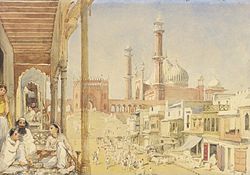
According to him -: India is the best country of word and India is the best historical place in word. India have so many freedom fighter like :- Bagat sing and chandreshekhr ajad and mahatma gandi ji and more...According to him Indian Culture is the best culture of word and there is so many cast of people. There is so many word heritage palace.
There has long been a rock movement in India, especially in cities like Calcutta, Bombay, New Delhi and later, Bangalore, Pune, and Madras, where during the 1950s, 1960s and 1970s, rock music from western countries gained a following. Indian rock music followed a long tradition of westernized/western music being played at night clubs and dance clubs in India, from the early 20th century onwards, primarily for an Anglo-Indian, and British clientele. Lounge acts, including swing bands, were popular in the 1950s, the decade after the British left, with rock 'n roll being followed from the mid 1950s onward by a very anglicized and westernized urban young audience, comprising both high school and college students, as well as the then very anglicized officer class of the Indian Armed Forces.
There were other major outlets for rock 'n roll (and later rock) music in India in the period from the 1950s to the 1970s. Of note were All India Radio or AIR, the state-owned radio monopoly which had a number of weekly pop music programmes. Some were regionally broadcast, such as Friday's A Date with You in Delhi and Northern India, while others such as the 1 hour long Monday evening Forces Request show were aired nationwide. All cities also had daily western pop music programmes broadcast by AIR, typically during the lunch hour. Later, in the 1970s, the new youth channel of AIR, Yuva Vani aired western top 20 pop music daily in a morning show. Radio Ceylon too had a major following in India, as elsewhere globally, and was the main source for hearing new music acts as they broke into the scene[citation needed].
India, uniquely then amongst developing markets, had a record industry in the Gramophone Company of India (an RCA/HMV/EMI subsidiary), and LPs, EPs, and 45rpm records were freely available, including those of rock and roll acts from the USA and Britain, but also of contemporary pioneering Indian rock bands. The president of the firm, Bhaskar Menon (who later became the President of Capitol Records in the United States) was the leading promoter of western pop music in India. Later in 1970, Polydor, the German Label, began an India label distributing rock music.
 We the Indians are ready to host the commonwealth Games 2010 & welcome the world to help us show India’s unique hospitability.
We the Indians are ready to host the commonwealth Games 2010 & welcome the world to help us show India’s unique hospitability.
The unprecedented unqualified and unbound support from all levels of Governments – National, regional and state as well as tremendous backing from the sports loving population of India will surely be fruitful and will make the event a memorable one.

The Masjid-i Jahān-Numā (Persian: مسجد جھان نما, the 'World-reflecting Mosque'), commonly known as the Jama Masjid of Delhi, is the principal mosque of Old Delhi in India. Commissioned by the Mughal Emperor Shah Jahan, builder of the Taj Mahal, and completed in the year 1656 AD, it is the largest and best-known mosque in India. It lies at the origin of a very busy central street of Old Delhi, Chandni Chowk.
The later name, Jami Masjid, is a reference to the weekly Friday noon congregation prayers of Muslims, Jummah, which are usually done at a mosque, the "congregational mosque" or "jāmi' masjid". The courtyard of the mosque can hold up to twenty-five thousand worshippers. The mosque also houses several relics in a closet in the north gate, including an antique copy of the Qur'an written on deer skin.
The foundation of the historic Jama Masjid (Friday Mosque) was laid on a hillock in Shahjahanabad by fifth Mughal Emperor of India, Shahjahan, on Friday the October 6, 1650 AD, (10th Shawwal 1060 AH). The mosque was the result of the efforts of over 5,000 workers, over a period of six years.[1]. The cost incurred on the construction in those times was 10 lakh (1 million) Rupees, and it was same Emperor who also built the who built the Taj Mahal, at Agra and the Red Fort, which stands across the Jama Masjid, which was finally ready in 1656 AD (1066 AH), complete with three great gates, four towers and two 40 m-high minarets constructed of strips of red sandstone and white marble [2].
Shah Jahan built several important mosques in Delhi, Agra, Ajmer and Lahore. The Jama Masjid's floorplan is very similar to the Jama Masjid, Fatehpur Sikri near Agra, but the Jamia Masjid is the bigger and more imposing of the two. Its majesty is further enhanced because of the high ground that he selected for building this mosque. The architecture and design of the slightly larger Badshahi Mosque of Lahore built by Shah Jahan's son Aurangzeb in 1673 is closely related to the Jamia Masjid in Delhi.
 India the best of all in one place
India the best of all in one place
Step out on some of the most fascinating and overwhelming mountains treks. Ski-down a few of the most picturesque snow slopes and enthrall your spirits.
Catch your breath on the most exotic beaches. Experience the masterpiece of creation and one of the seven wonders ‘Taj’. You can get all this only in India. Adventure Excitement Exhilaration Ecstasy; Experience them the way you want to. Explore native forests.



Udaipur - Jaipur - Ranthambore - Agra - Orchha - Khajuraho - Varanasi


Valley Of Flower - Hemkund Sahib


